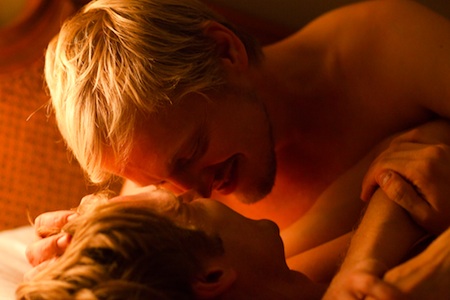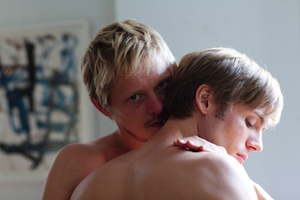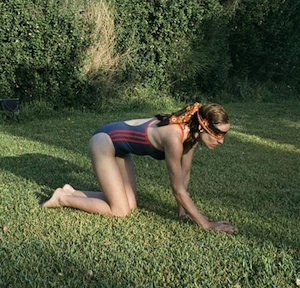Focused and perceptive, piercingly honest and subtly funny, Ira Sachs directs films that are, in his own words, autobiographical—“even the story of a Russian woman living in Memphis.” But Keep the Lights On, which opens in limited distribution on September 7, is a film particularly close to Sachs’ heart. It’s about a disintegrating relationship, a story of sexuality imprinted on everyday life as naturally as morning coffee, breathing or sleep. Its melancholic picture paints doom while offering the promise of a new, fuller life rising from the ashes. Sachs is an accomplished director, mentor and activist, the 2005 winner of Grand Jury Prize at Sundance (for Forty Shades of Blue) and recipient of 2012 Teddy Award in Berlin, a prestigious prize for best LGBT feature awarded in past years to Derek Jarman, Todd Haynes and Pedro Almodóvar.
Keyframe: Most directors are interested in capturing spectacular, intense moments of being. Your film, however, tends to touch upon what’s in between.
Ira Sachs: It’s interesting, because of all my films, this one has the most moments of real activity. But I am very interested in things that happen in between. I feel like I made a film in which every scene is about what happens when people are going to the bigger events. How do you get there is really an issue. There’s a collage element to the film: it’s a series of photographs, images, a series of events that may begin to gather steam emotionally because they are placed against each other. And I think on that level the film reads like a diary, like a memoir. I have always felt that one of the ways of making the film rich is to bring the world into it. Initially Keep the Lights On came out of a very autobiographical place. In 2007 I ended a relationship that I’d been in for 10 years. It ended on a certain day; there was this one day, when it was over. But even then I recognized there was also a day it had begun. Somewhere out there, in between, there was a good story, a story that creates its own sets of issues, you just had to focus on it. Though I would say there are certain themes in the film, beginning with the title. It was this driving question I kept on asking myself: How much do we reveal ourselves to other people? These are two men who live with a certain lack of transparency. And I think the film is really a process, which does connect a lot of my own life, in which I went from a place of many sets of secrets, those ‘Russian dolls’ hiding several other beings inside, and then at a certain point, everything was sort of lifted. It allowed you to look under.
Keyframe: How did your ex- partner react to the idea of a film so intensely inspired by your relationship?
Sachs: He was fine with it. I shared the script with him. He made a few small comments, but not many. He knew me as an artist and had respect for what I was doing. Also what happens is that it begins in a place that’s very autobiographical and then it becomes something completely different. The film is about characters played by Thure Lindhardt and Zach Booth, it’s their story. I think all my films are autobiographical, to tell you the truth. Even when I made one about a Russian woman living in Memphis, that was me as well. The only thing my ex said was: ‘Make sure he’s hot!’ [Laughs.]
Keyframe: Mission accomplished! Was it difficult to find actors, who wouldn’t be afraid of these parts?
Sachs: It was tough to find good actors. It’s always a process to find a lead actor in a film; he or she doesn’t just walk in a room. It was not surprising that I ended up with a non-American in the lead. We’re Puritans—and that still exists; there’s a fear of nakedness. The imagery in America is much more oppressed now than it was 30 years ago. I casted Zac [Zachary Booth, playing Paul] first. Finding an actor who could play Eric was more difficult. And then a screenwriter friend recommended Thure [Lindhardt]. I worked with non-american actors before and I really respond to that style. To me it was a natural leap. Also, once I casted a blonde Danish guy, it immediately took the film away from an autobiographical place, and I liked that. I wanted to make A FILM. Filmmaking is about understanding drama and narrative… the film is a novel.
I think all my films are autobiographical, to tell you the truth. Even when I made one about a Russian woman living in Memphis, that was me as well. The only thing my ex said was: ‘Make sure he’s hot!’
Keyframe: One of the wondrous aspects of remembering is selectivity—certain moments that were painful or difficult very often tend to fade with time. To me it seems like it’s the ability to forget that makes Eric and Paul’s relationship possible, allows it to last.
Sachs: I think that’s true. I also think that though it’s just a series of images, you can also see the advantages of having a really good co-writer. Mauricio Zacharias, a Brazilian screenwriter (Madame Sată) is simply crafted. In order to tell a story of ten years you have to choose the elements that are necessary. The comfort I think the audience has is that they know the story is not purely observational; it’s being told.
Keyframe: Why did you decide to collaborate with Greek cinematographer Thimios Bakatakis, responsible for—among many others—the widely awarded, even Oscar-nominated Dogtooth?
Sachs: What I liked about Dogtooth is the intimacy of the camerawork and the gentle kind of lighting that has beauty and sympathy to it. He lights with empathy. He is also not afraid of the human body and of sexuality. I feel like for Thimios a naked body and a lamp are the same thing: just objects that you light. That kind of neutrality was central to the film; because sex and sexuality are not separate from the everyday, but a part of it.
Keyframe: There are many deeply intimate scenes in the film, very sexual moments. But somehow, even though physiology is by no means beautified, you never lose subtlety, never become too explicit.
Ira Sachs: It’s a story of building a life, a coming-of-age film. As the relationship disintegrates, the characters are coming into their own. Sex is a part of the story, the emotional journey, like in every relationship. Each time it exists it means something to the story: it advances, detracts, it moves it in a certain way. It’s never outside of the story, which would make it extraneous or exploitative. I cast actors who are really comfortable with their bodies. The first sex scene we shot on the second day of shooting, which was actually a really good idea. We did all the moaning and groaning and wide-shot sex scenes in the beginning. We kind of got through that as a crew, and the rest of it was easy. It’s also about blocking the camera. There’s a really wonderful movie we were very influenced by: Jack Hazan’s documentary about David Hockney called A Bigger Splash (1973). Actually the wide shot we used in Keep the Lights On is taken directly from it. It was so bold to see a wide sex shot. This is not what people do! It immediately drew my attention. It’s a really beautiful, fascinating film. In Keep… we’re not doing penetration or erect penises—we’re not having that kind of sex. When the bodies touch it’s always sexual. But it’s a lot about placing the camera to figure out how the image can say what the author wants it to, without the actors having to do what none of us would like to do.
What I liked about ‘Dogtooth’ is the intimacy of the camerawork and the gentle kind of lighting that has beauty and sympathy to it. He lights with empathy. He is also not afraid of the human body and of sexuality. I feel like for Thimios a naked body and a lamp are the same thing: just objects that you light. That kind of neutrality was central to the film; because sex and sexuality are not separate from the everyday, but a part of it.
Keyframe: Do you pay a lot of attention to other filmmakers’ work? Do other films inspire and influence you the way Hazan’s film did?
Sachs: I work through other films and filmmakers. That’s also how I worked with my cinematography. Usually with my films there is one God. With Forty Shades of Blue it was Ken Loach, here we studied four or five Maurice Pialat’s films. Also Godard and his Passion was crucial. Mainly because he shot a lot of images that are like portraits. That portraiture as a way of moving images forward was something we were aiming for. It’s not imitation, it’s education.
Keyframe: How important was Arthur Russell to you? His music is carrying us through your film.
Sachs: I saw a film, Wild Combination, which is a documentary about him and was really touched by the music. It became kind of a guiding light for us. I made a decision to use vocalized songs by one artist to create a sort of overall third character, third eye of the film, so to speak. Arthur died in 1992 of AIDS. Now I’m working on a fiction film about him and his relationship with a man called Tom Lee. They were together for 10 years and endured a lot of adversity both professional, creative and health, yet made a lot of truly beautiful stuff. It’s a story of an artist, but first of all, a true love story about how love can be a gift as opposed to a thorn.
Keyframe: How important are the people you work with to your creative process? You seem to have a great team, not only in the film world, but also at the university where you teach.
Sachs: I hire pretty well. That’s part of what directing is about: understanding collaboration. It’s central to making movies. It’s a bit like casting. It’s always easier to work with people that you enjoy, who have the same goals. Like in a relationship: if your values are similar, then you’re gonna get along better. I think as a director what I try to do is listen really hard—but then make my own choices. I’m very open to opinions, because if they trigger something in me, I’m interested. I never resist them. Sometimes you take some things better that other, but then just try to overwork them as another stimulation for the decision-making process. I teach film at NYU, in graduate school. I run an art class and consider my students fellow filmmakers, I’m engaging intellectually and creatively with their work. I encourage them to doubt their teachers. Teaching forces me to consider my own process, which is really helpful. I also think that being around another, younger generation makes you consider how you work in new, different ways. I was watching my students work and in January [2011] I said, ‘I’m just gonna make a film. If they can do it, I can do it. I don’t need to wait three years for Hollywood to finance it!’ And I completed it in July. That’s a very different time scheme. I’m interested in a communal nature of life. As an activist, but also, more selfishly, as a way to feel a part of something. To belong, and to be stimulated. I don’t think anyone is an activist for truly altruistic reasons. You’re an activist because you like that position and the impulse that comes with it.
Keyframe: Activism is very often connected with ideology, which is something that does not really manifest itself in your films.
Sachs: I think there is some kind of ideology there, ideology of history. I’m interested in chronicling stories that are not seen. Like I think every artist is. You have to believe you’re the one person that can tell this story. I wouldn’t make a film if I didn’t have something that people could hold on to. I don’t start a script until I have a log-line—a one sentence description, which is a way the Hollywood approaches it. But I’m not having it to pitch it, but to understand it. For me Keep the Lights On was about the first and the last day of a relationship. Then I thought, ‘OK, I can make the movie.’
Usually with my films there is one God. With ‘Forty Shades of Blue’ it was Ken Loach, here we studied four or five Maurice Pialat’s films. Also Godard and his ‘Passion’ was crucial. Mainly because he shot a lot of images that are like portraits. That portraiture as a way of moving images forward was something we were aiming for. It’s not imitation, it’s education.
Keyframe: You’ve been making films for almost 20 years now. Is there anything that has significantly changed over this period of time?
Sachs: Making films now is different from what I imagined when I started. It’s interesting: There are many gay and lesbian filmmakers nowadays that stopped creating imagery that has specifically queer context. I think that economics have caused a lot of gay filmmakers to closet the specifics of their own lives, and stopped them from putting gay characters in their own films. We’re all influenced by the economy. Queer cinema started with the idea that it needs to be about the identity. This is the transition from then to now. My film is not about identity; it’s about behavior. In that way that is a progress. These are gay people living in a very mixed world, which is the part that I think most of us now experience. There are no more distinctions. Of course, there are many bubbles we live in. We are the educated class; there are certain parameters to it. But I don’t make them anymore.
Keyframe: Was there anything particularly difficult for you to relieve during the shoot?
Sachs: By the time I finished the script nothing was difficult on that level. I had revealed all the secrets to my ex previously, in the process of breaking up. I had an intimacy with the material, but I also had a distance. Sometimes it was kind of fun to see those moments that were really terrible in real life now being played. But it never affected me on the emotional level. It was almost like having a déjà vu that you could stop at any time, if you only wanted to.







